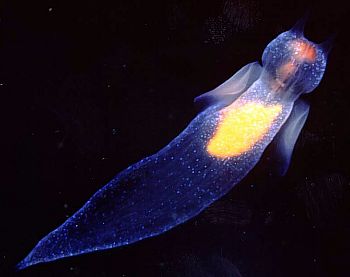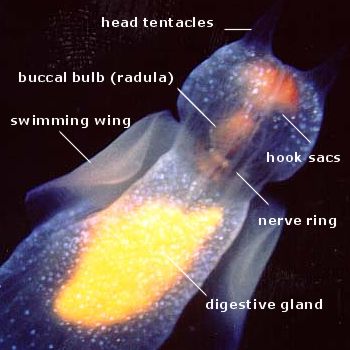

Clione limacina
(Phipps, 1774)
Order: GYMNOSOMATA
Suborder: GYMNOSOMATA
Family: Clionidae
DISTRIBUTION
Northern Hemisphere in polar and cold temperate waters - Pelagic
PHOTO
Quadra Island, near Campbell River, Vancouver Island, British Columbia, Canada. Photographed in 1999, just beneath the surface. PHOTO: Marli Wakeling.
Clione limacina is a relatively common non-shelled (gymnosomatous) pteropod and appears to feed exclusively on species of the shelled (thecosomatous) pteropod genus Spiratella. it grows to about 25mm in length. Lalli (1970) studied its feeding behaviour in laboratory studies, which showed how the unique feeding apparatus of these gymnosomatous pteropods functions.
When C. limacina makes contact with its prey it rapidly everts a set of six buccal cones, which are in fact eversible tentacles, which grab the shell of Spiratella and turn it around until its shell opening is facing the mouth of Clione. At this stage large chitinous hooks are everted from a pair of sacs, called hook sacs, and grasp the prey animal. It takes about 30 minutes for C. limacina to pull Spiratella out of its shell and to swallow it whole. At this point it drops the empty shell. Clione and Spiratella are well-known to fisheries biologists as common members of the plankton in fishing grounds. They are usually found associated with each other and as is usual in carnivore and herbivore prey relationships the ratio of prey to predator is very high, often reachng more than 500:1. Clione limacina is itself eaten by fish and sea birds.
Clione limacina was previously considered to have a bipolar distribution but Gilmer & Lalli (1990) show many internal and external differences between northern and southern hemisphere populations and consider the southern populations should be considered a distinct species, C. antarctica (Smith, 1902).
-
Gilmer, R.W. & Lalli, C.M. (1990) Bipolar variation in Clione, a gymnosomatous pteropod. Am. Malacol. Union Bull. 8(1): 67-75.
-
Hermans, C.O. & Satterlie, R.A. (1992) Fast-strike feeding behaviour in a pteropod mollusk, Clione limacina Phipps. Biol. Bull., 182: 1-7.
-
Lalli, C.M. (1970) Structure and functioning of the Buccal Apparatus of Clione limacina (Phipps) with a review of feeding in gymnosomatous pteropods. Journal of experimental marine Biology and Ecology, 4: 101-118.
-
Lalli, C.M. & Gilmer, R.W. (1989) Pelagic Snails. The biology of holoplanktonic gastropod molluscs. Stanford University Press: Stanford, California.
-
Morton, J.E. (1958): Observations on the gymnosomatous pteropod Clione limacina (Phipps). Journal of the Marine Biological Association, United Kingdom, 37: 287-297.
Rudman, W.B., 2001 (May 14) Clione limacina (Phipps, 1774). [In] Sea Slug Forum. Australian Museum, Sydney. Available from http://www.seaslugforum.net/factsheet/cliolima
Related messages
-
Re: Clione limacina in Greenland
From: Andy Murray, November 26, 2007 -
Re: Clione limacina in Greenland
From: Andy Murray, November 12, 2007 -
Pteropods from New Jersey, USA
From: Kate Winters, October 3, 2007 -
Clione limacina in Greenland
From: Andy Murray, September 14, 2007 -
Re: Clione limacina from Newfoundland, Canada
From: Rob Freyer, June 27, 2007 -
Clione limacina from Newfoundland, Canada
From: Ryan Murphy, June 21, 2007 -
Does Clione limacina have eyes?
From: Sim Kah Chine, December 12, 2006 -
Clione limacina - how to keep alive?
From: Julie Lim, April 14, 2005 -
Clione limacina from Quebec, Canada
From: Chantal Croteau, June 25, 2003 -
Bipolar distribution of Clione and Limacina
From: Yasuhiko Ito, May 2, 2003 -
What should we feed Clione?
From: S. Kumagai, March 28, 2003 -
Clione do exist!
From: Paul Dymond, March 2, 2003 -
Re: Where do I find Clione limacina?
From: Marli Wakeling, May 19, 2001 -
Where do I find Clione limacina?
From: Josh Rosenthal, May 15, 2001
